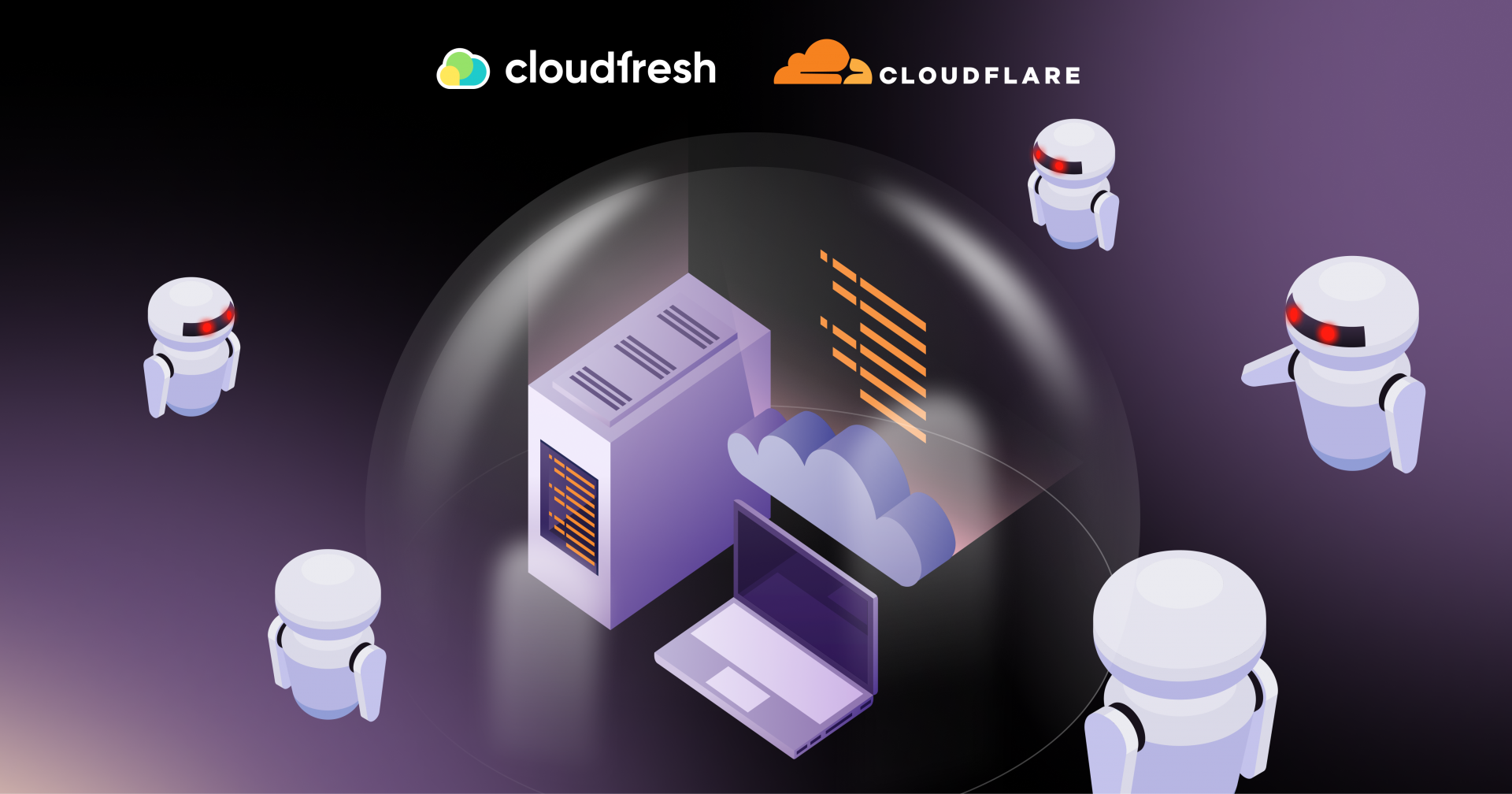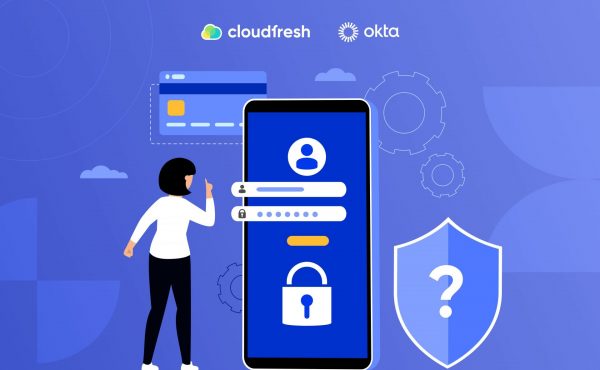AWS vs Azure vs Google Cloud
How to Mitigate DDoS Attacks: Best Practices
- Current State of Things

- Key Types of DDoS Attacks and Their Vectors

- How to Protect against DDoS: 4 Areas to Focus On

- How to Prevent a DDoS Attack by Type

- There’s no Denial: Your DDoS Protection Would Win with Cloudfresh

Distributed Denial-of-Service (or “DDoS” for short) attacks aren’t slowing down. On the contrary, they’re getting bigger, stronger, and smarter.
It’s not just a trend; it’s a full-on spike. Companies that deal with cyber threats daily are seeing the shift up close. Cloudflare, for example, blocked 27.8 million DDoS attacks in just the first half of 2025. That’s already 130% more than they stopped in all of 2024.
The message is clear: the need for cybersecurity services is rising, and it’s rising fast.
Current State of Things
Suffering a DDoS attack isn’t just a tech issue but also a financial gut punch. On average, big companies take a US$2 million hit. For smaller businesses, the damage still adds up fast at around US$120,000 per incident.
But that’s only part of the story. It’s not just the cost of fixing things. Downtime grinds work to a halt. Teams lose hours. Customers lose trust. And the brand image..? It gets struck, too.
Then come the ripple effects—credit scores, insurance ratings, long-term risk exposure. It all snowballs.
And no one’s off the radar. Tech firms, banks, hospitals, government offices, and e-commerce platforms, no matter big or small, are all in the crosshairs, meaning they need to know how to mitigate DDoS attacks as part of their broader efforts.
The Largest DDoS Attacks to Date
Let this sink in: back in 2023, Google stopped one of the biggest attacks ever recorded, peaking at over 398 million requests per second. It used a new tactic called HTTP/2 Rapid Reset. Fast forward to Q2 2025, and Cloudflare topped that, blocking a massive 7.3 terabit-per-second attack.
The pace and power of these are heading in one direction—up. And for businesses and service providers, that’s a flashing red warning light. It’s time to rethink how to prevent DDoS attacks.
One trend turning up the heat? Ransom DDoS. More companies are being threatened with these pay-up-or-go-down attacks. In Q2 2025 alone, Cloudflare saw a 68% spike in ransom-related incidents compared to the previous quarter and a 6% jump over Q2 of 2024. The shift from disruption to extortion makes these threats even harder to manage.
There’s another twist. Most modern DDoS attacks don’t drag on. They hit hard and vanish. In Q2 2025, 92% of network-layer attacks and 75% of HTTP attacks lasted less than 10 minutes. That infamous, record-breaking 7.3 Tbps strike? It was over in just 45 seconds.
These rapid-fire assaults are built to do damage fast and slip under the radar before anyone notices. Traditional, manual defenses can’t keep up. That’s why always-on, automated cloud protection isn’t optional anymore. It’s essential.
Key Types of DDoS Attacks and Their Vectors
Not all DDoS looks the same. It comes in different forms, hits different parts of your system, and needs different kinds of defenses. And as bad actors evolve, so do the attack tools and methods they use.
Volumetric Attacks
These are the blunt-force. They flood your network with massive amounts of traffic, more than your systems can handle. Tactics like DNS amplification or UDP floods are common here. The goal? Eat up all available bandwidth and bring everything to a standstill. Figuring out how to mitigate DDoS attacks like these takes serious firepower—huge capacity, fast filtering, and “scrubbing centers” that clean the Internet traffic before it ever reaches you.
Protocol Attacks
These go deeper. Instead of overwhelming your Internet pipe, they mess with the nuts and bolts of your system, that is, layers 3 and 4 of the network stack. One classic example is the SYN flood, which overloads a server’s connection table and blocks real users from getting through. Beating these means digging into the traffic patterns to spot suspicious behavior and cut it off before it causes damage.
Application-Layer Attacks (Layer 7)
This is where things get sneaky as these attacks look a lot like regular users clicking around on your website. They’re designed to feed on specific flaws in your applications (think of HTTP floods, SQL injections, or cross-site scripting). Because they mimic normal traffic, they’re hard to catch and even harder to block without disrupting real users.
Multi-Vector Attacks
Attackers aren’t picking just one method anymore. They’re combining everything—volumetric, protocol, and application-layer—all at once. The result? Complex, layered strikes that overwhelm defenses from multiple angles. Fighting back takes more than one tool. How to prevent a DDoS attack this sophisticated? The answer is a coordinated, multi-layered strategy.
Advanced Botnets
Today’s DDoS botnets are smarter and tougher to spot, and many rely on hijacked IoT devices. Think smart cameras, routers, and other gear with weak security. Botnets like Mirai and GAFGYT use these devices to launch powerful distributed attacks. And since the devices are everywhere, shutting them down isn’t easy.
AI-Powered Attacks
Cybercriminals are now using AI to make their strikes even sharper. From smarter phishing emails to evolving malware and automated vulnerability scans, AI makes these attacks more targeted and harder to detect. They adapt on the fly, often slipping past traditional defenses.
API Exploitation
Forgotten or undocumented APIs, which are often called “shadow” or “zombie” APIs, are becoming a favorite target. These blind spots are wide open for abuse. To stop it, defenders need API management and behavioral analytics that can spot unusual patterns and flag suspicious requests before they slip through.
DDoS attacks aren’t just about incoming traffic anymore. They’re about strategy, stealth, and precision. Instead of hammering the front door, attackers are slipping in through the cracks quietly, cleverly, and with purpose.
That’s why the old answers to the question of how to protect against DDoS, such as signature matching, static thresholds, and manual filters, just aren’t enough. What’s needed now are intelligent systems that learn, adapt, and respond in real time. Solutions powered by behavior analysis and AI that can spot threats hiding in plain sight.
The game has changed. Defenders have to change with it. And that means building layered defenses, staying proactive, and making resilience a part of your architecture from the ground up.
How to Protect against DDoS: 4 Areas to Focus On
Below, you will find some of the best practices to prevent DDoS.
Area 1. Architectural Resilience and Network Hygiene
Strong defenses start with smart design, so simply blocking bad traffic isn’t gonna cut it. You have to build systems that can take a hit and keep going.
Leave no room for a single point of failure. Spread your infrastructure out. Use load balancers, backups, and failover systems to make sure your services stay online even if one location is under attack. Big platforms design for scale, with plenty of server capacity and bandwidth to absorb the blow when attacks hit.
Content Delivery Networks (CDNs) are a huge help when it comes to how to mitigate DDoS attacks. Services like Cloudflare keep static content closer to users and take on traffic at the edge of the network before it reaches your server resources. With hundreds of data centers and terabits of mitigation power, Cloudflare can spot and stop attacks in under three seconds without rerouting traffic through a central filter that slows things down.
But it’s not just about scale. It’s also about shrinking the target. Keep your origin servers hidden. Don’t expose more than you have to. Use firewalls and ACLs (Access Control Lists) to control who can reach what. Put sensitive systems behind load balancers or CDNs and limit direct Internet access wherever possible.
Microsegmentation is another move you can make. Break your network into smaller zones, each with its own rules. If one part gets hit, the attacker can’t jump to the next. That kind of isolation narrows the attack surface and makes a big difference, especially if someone does slip past the front line.
And let’s not forget the basics, that is, patch everything. Outdated software is an open door. Many breaches could be avoided with simple updates. Make it routine. Watch for vulnerabilities and fix them fast.
Area 2. Leveraging AI, Machine Learning, and Behavioral Analytics
Modern DDoS attacks are fast, flexible, and constantly changing. Manual defenses can’t keep up. That’s where AI, machine learning, and behavioral analytics come in to help turn raw data into understanding how to prevent a DDoS attack and take real-time action.
These tools watch your network 24/7, learning what normal looks like—things like traffic volume, connection rates, and typical user behavior. When something weird happens (like a traffic spike from a strange location), they know it’s probably not just a busy day and flag it immediately.
Machine learning models can adapt on the fly. They recognize multi-vector attacks and automatically trigger the right responses, whether that’s filtering traffic, limiting connections, or spinning up extra resources. Unlike relying on static rules, these systems adjust to what’s happening in real time.
Behavioral analytics is especially good at spotting sneaky application-layer attacks. These aren’t blunt-force. These are calculated. They mimic real users, use valid credentials, and try to blend in. But with AI tracking things like navigation patterns, request frequency, and bot-like behavior, even subtle attacks stand out.
One big benefit? Fewer false alarms. These systems can tell the difference between a spike in real users and a quiet, clever DDoS attempt. That means fewer disruptions and better protection, all without slowing down your legitimate traffic.
Nowadays, this kind of autonomous defense is a necessity, not a luxury. Attacks move too fast for humans to catch them in time. AI, ML, and behavioral tools give you the speed, precision, and adaptability needed to stay one step ahead, and they are rightly among the most efficient practices to prevent DDoS attacks.
Area 3. Zero Trust Architecture for All-Around Security
Zero Trust doesn’t stop a DDoS flood at the edge. But it makes your organization much harder to hit and much harder to hurt.
The core idea is simple: trust nothing, verify everything. Every device and user is checked, and access is only granted if they meet strict rules. That includes:
- Continuous identity checks.
- Least privilege access.
- Strict device controls.
For starters, you limit how attackers can move if they get in. If they breach one point, they can’t hop around the network without hitting more walls. That’s a big deal, because DDoS isn’t always a standalone attack. It’s often part of a larger campaign, sometimes a smokescreen for ransomware or data theft.
By locking down accounts and devices, Zero Trust reduces the risk of attackers using compromised systems to launch or amplify DDoS attacks, especially application-layer ones.
It also helps to have threat detection to stop internal denial-of-service attempts, which external defenses might miss. Microsegmentation and constant re-verification contain threats quickly, keeping the damage small and isolated.
Of course, Zero Trust isn’t plug-and-play. It takes planning, executive support, and trained people. Working with security partners or appointing a Chief Zero Trust Officer (CZTO) can help get it done right.
Think of it this way: Zero Trust doesn’t replace DDoS protection but strengthens it. It’s one more layer in a full-stack defense and mitigation strategy that makes your network more secure, more adaptable, and more resilient to whatever comes next.
Area 4. How to Mitigate DDoS Attacks and Respond to Incidents (If Any)
Even with the best defenses, some attacks will get through. That’s why response planning is just as important as preventing DDoS attacks.
A good incident response plan gives your team a clear roadmap when things go wrong. It covers every phase: detection, analysis, containment, recovery, and follow-up. And it spells out exactly who does what.
Build a dedicated team that includes network ops, security, and system admins. Make sure they know their roles and how to mitigate DDoS attacks in terms of follow-up communications. That includes everyone from top execs and legal teams to ISPs, hosting partners, and even customers.
Don’t just write the plan—test it. Run simulations. Train your people. The more often you practice, the faster and smarter your team will respond should things go south.
Also, look into Cyber Threat Intelligence (CTI). It will help you understand your attackers, spot trends, and tailor defenses.
And don’t overlook identity and access management (IAM) solutions. Many DDoS campaigns start with stolen credentials or phishing scams. Locking down access helps cut those attacks off at the source before they ever reach your infrastructure.
How to Prevent a DDoS Attack by Type
Dealing with DDoS can feel like a migraine. One minute everything’s fine, the next you’re in digital pain. But guess what? You don’t have to suffer through it. We’ll walk you through the various ways these attacks hit and, more importantly, how you can neutralize each one and keep your business flowing.
DNS Flood
Use Cloudflare DNS as your primary or secondary resolver, and enable DNS Firewall or Magic Transit for added protection. Cloudflare’s global network filters malformed or excessive DNS traffic while caching and serving queries coming from legitimate users. It handles tens of millions of DNS requests per second, automatically blocking floods before they reach your origin.
SYN Flood
Deploy Cloudflare Magic Transit to stop SYN floods at the edge. It uses SYN cookies, connection tracking, and behavioral analysis to separate real users from spoofed IP addresses or malicious traffic. For additional protection, route traffic through Cloudflare Spectrum (for TCP) or Cloudflare’s CDN/Web Application Firewall (for HTTP). These reverse proxies prevent direct access to your origin and block TCP-based DDoS traffic before it causes harm.
UDP Flood
Been wondering how to prevent a DDoS attack that sends in UDP flood traffic? Use Magic Transit or Spectrum to identify and drop it in real time. Combine this with Magic Firewall to apply smart rate limiting or block unwanted UDP packets entirely, keeping your infrastructure protected from volumetric surges.
Teeworlds
Protect your game servers using Cloudflare Spectrum or Magic Transit. Cloudflare automatically fingerprints and filters out DDoS traffic while allowing real players to connect. For extra control, use Magic Firewall to craft custom rules that stop attacks at the packet level.
RIPv1
Disable RIPv1 on all routers and switch to RIPv2 with authentication if routing is required. Block inbound UDP port 520 from untrusted networks and monitor for unusual routing activity to catch potential abuse early.
RDP
Use Magic Transit to block spoofed or malformed RDP traffic before it hits your origin. To secure remote access at the application layer, move RDP behind Cloudflare Gateway or Zero Trust Network Access (ZTNA), which require authentication and help prevent abuse of open RDP services.
DemonBot
How to protect against DDoS that’s carried out via DemonBot? Turn to Magic Transit, which filters massive floods at layers 3 and 4. Cloudflare identifies infected traffic using real-time analysis and signature detection. For Layer 7 attacks, use Cloudflare’s WAF and DDoS protection to block HTTP floods and connection abuse.
VxWorks Flood
Deploy Magic Transit to filter DDoS traffic from compromised VxWorks devices. Cloudflare detects and blocks this traffic using custom heuristics and live fingerprinting. For application-layer protection, combine with Cloudflare Gateway and WAF services to defend against protocol-level abuse.
There’s no Denial: Your DDoS Protection Would Win with Cloudfresh
Cloudfresh is a Select-tier Cloudflare partner well-versed in all the best practices to prevent DDoS, both classic and up-and-coming.
Cloudflare itself earns high marks from users, but you don’t have to take our word for it. Scored 4.6 out of 5 based on hundreds of reviews, it’s often called a “cornerstone of edge security” for SaaS platforms.
That’s thanks to its ability to fend off both volumetric and application-layer attacks without slowing things down, according to Gartner. Users consistently highlight its massive global network, smart traffic filtering, minimal false positives, and reliable performance, even under intense load.
If you’ve been wondering how to mitigate DDoS attacks (and even better, prevent them altogether), but haven’t had the proper tooling, feel free to fill out the short form below, and we’ll set you up for success.














